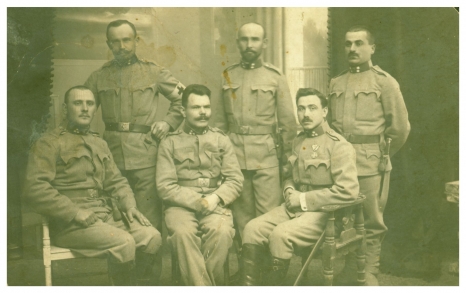The 100th anniversary of Poland’s regaining independence is an excellent opportunity to highlight the events that directly contributed to shedding the yoke of foreign partitions. The presented exhibition focuses on the most significant aspects of World War I in the San River region and the fates of its inhabitants during this dramatic time. Approximately 10 million soldiers of various nationalities died during World War I. For nearly four thousand of them, war cemeteries established at the confluence of the Vistula and San Rivers became their final resting places, directly resulting from the bloody battles fought from Rozwadów to Tarnobrzeg by soldiers of the Central Powers and Russia. Poles were also involved in this fraternal fight on both sides of the global conflict, conscripted into the partitioning armies. Those mobilized from the former Tarnobrzeg district, aged 21 to 37, were mainly assigned to the 17th or 40th Infantry Regiments of the Austro-Hungarian Army stationed in Rzeszów. About 200 volunteers from the district joined the Polish Legions.
An important part of the exhibition will be dedicated to the participation of the inhabitants of Lower Nadsania in the legions and the support they received from the local community. This section will primarily consist of military artifacts, decorations, leaflets, photographs, and biographies of legionnaires. A significant element of the exhibition is the presentation of the artistic works of the legions: songs and poems that accompanied the soldiers on their journey to freedom and became a kind of chronicle of legion battles, eventually entering the canon of patriotic works.
The exhibition will also recall the dramatic course of military actions. From August to September 1914, the region became a concentration area for the Austro-Hungarian 1st Army before the offensive on Lublin and later its retreat battles. The front halted here for the second time from October 9 to November 3, 1914, when fierce battles occurred, including under Rozwadów. Finally, the last fights took place here in June 1915 during the so-called recapture of Galicia by the Central Powers. In this section of the exhibition, we will showcase typical weaponry for infantry and cavalry, firearms, and cold weapons from both sides of the conflict, which the region’s inhabitants witnessed in the fall of 1914 and summer of 1915. Historical artifacts will be accompanied by illustrative materials, unique photographs presented in traditional and digital forms. A crucial part of this section will highlight the profiles of Nadsania residents who were subjects of the Habsburg monarchy, mobilized and participated in battles during World War I. The narrators of this initial phase of wartime events are three exceptional figures: Gen. Tadeusz Jordan Rozwadowski, Gen. Juliusz Bijak, and painter Wojciech Kossak. The decisive criterion for selecting these narrators was their presence in the San River region in the early weeks of the war and the published memoirs they left behind.
After the end of World War I, Lower Nadsania was a vast battlefield. The introduction to the next part of the exhibition will consist of drawings documenting the ruined towns: Rozwadów, Nisko, Ulanów, and Rudnik nad Sanem. In 1918, these were made by Stanisław Janowski, a painter and legionnaire. A symbolic culmination of the wartime and independence aspirations of local activists was the day of November 2, 1918. On that day, in the now non-existent village of Brzóza (Stalowa Wola district), on the border of the Austrian and Russian partitions, the inhabitants of Radomyśl and nearby villages tore down border posts that symbolized over a century of division of Polish lands. Panels with double-headed eagles of the former monarchies will be part of the exhibition.
The exhibition will also address the most tragic remnants of World War I, the numerous graves and cemeteries that have become a permanent part of the Nadsania landscape. The Regional Museum in Stalowa Wola has exhibits from archaeological and exhumation work conducted between 2014 and 2017 at World War I cemeteries in Zdziary, Domostaw, and Kłyżów. Only a portion of this unique collection will be presented at the exhibition, mainly consisting of fragments of uniforms and small metal devotional items. Exceptional finds include examples of regimental emblems and medals. Additionally, film and photographic materials documenting the progress of archaeological and exhumation work in the field will be presented.
Curators: Aneta Garanty, Monika Kuraś
The project is implemented as part of the centennial celebrations of regaining independence.

The exhibition is accompanied by a dedicated educational program that includes museum lessons and art workshops:
